We need your help! A reader recently purchased an unsigned painting with unusual qualities that hint it could be by a master. What do you think?
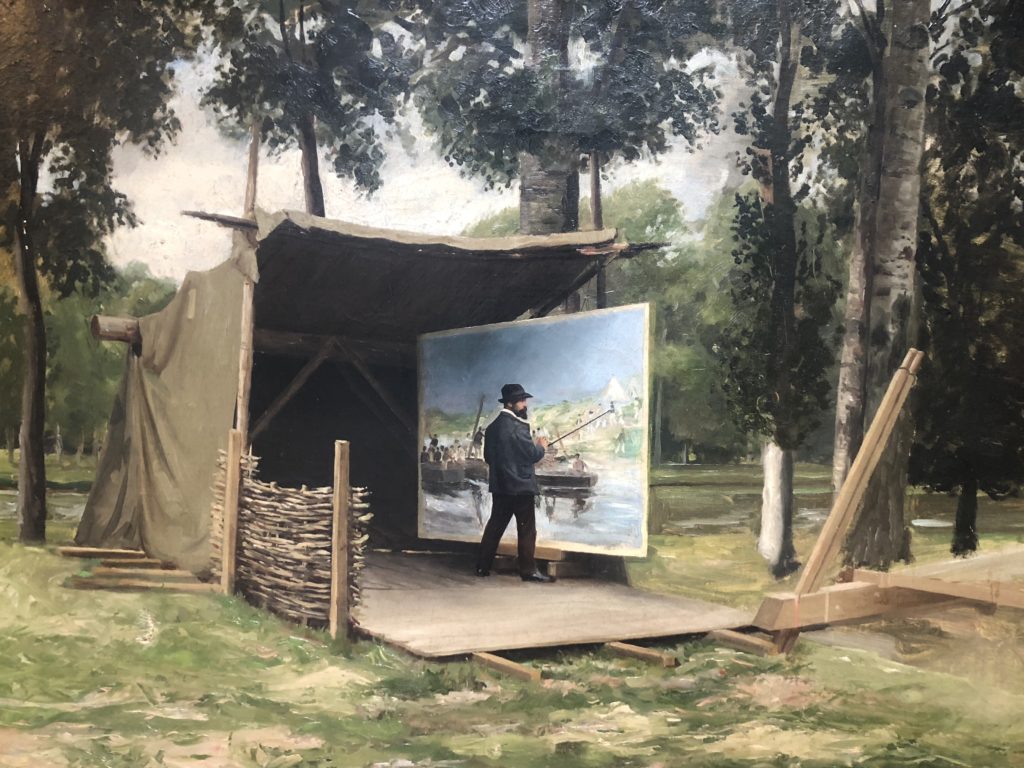
Letter to the Editor:
I am writing to you about a fascinating painting of an artist at work on a canvas in the open air, sheltered by a strange structure built of wood with tenting materials — tarpaulins — and an odd woven willow fence.
I’ve never seen anything like it. As an image of an artist at work it is very unusual, with all of the attention to the structure he has set up for protection. That it isn’t signed is also strange, but perhaps the artist who painted it intended it as a private painting, rather than one to sell or to give away.
I bought this painting in France, near Paris. While Sorolla and Tattegrain had devised special mobile structures to paint, they did not look like this one.
The question is whether it is a self portrait or a tribute of a painter to another painter …
Furthermore, the size of the canvas (55 x 74 cm) that is underway in outdoors would be quite unusual for a French painter (apart from Impressionists, but the size of their work does not match at all).
There are the initials “AB” at the back of the frame, on the central piece of woodwork.
Do you think it could be a late 19th-century American artist?
Signed,
Damien Forest
Details of the painting image:
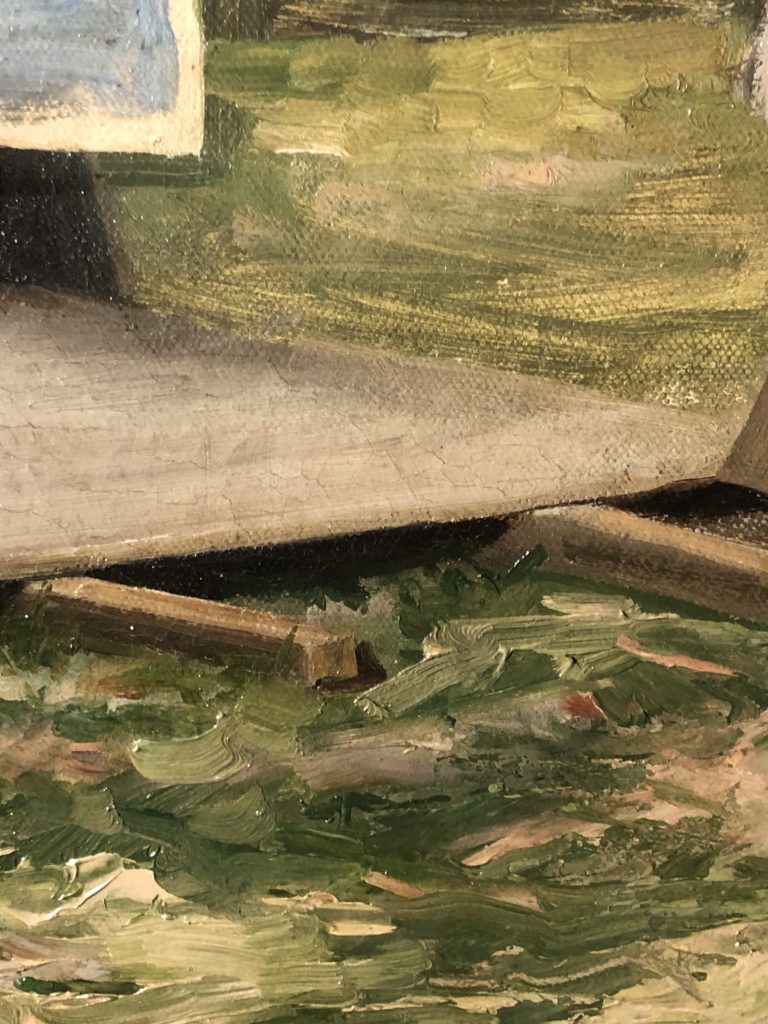
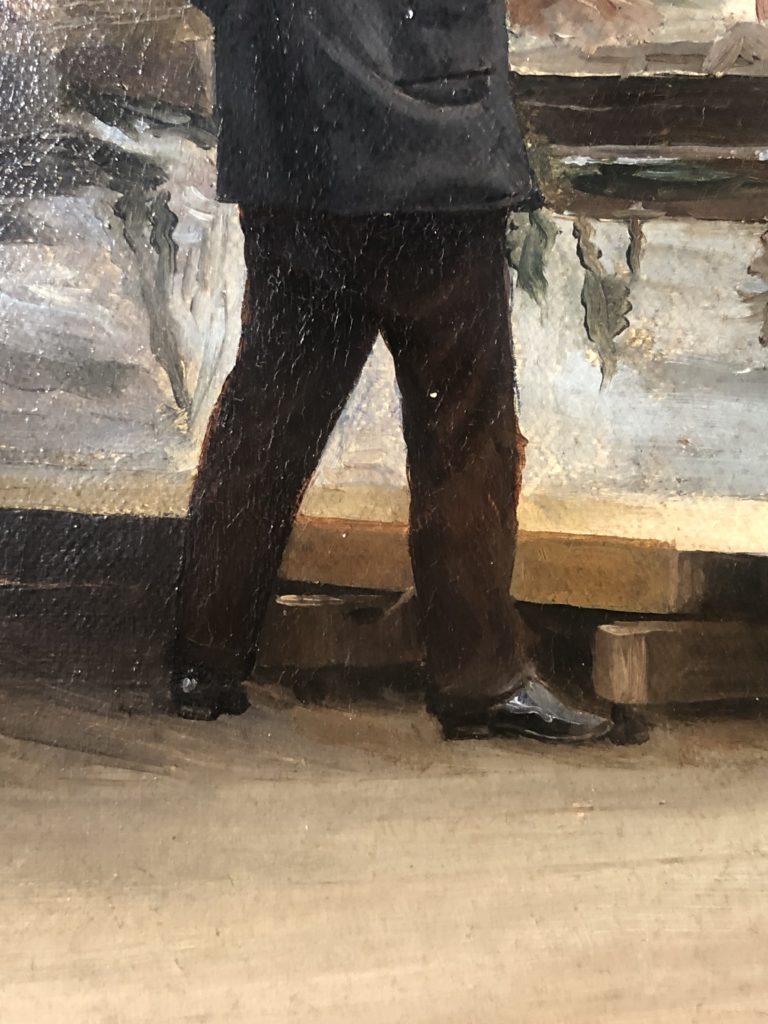
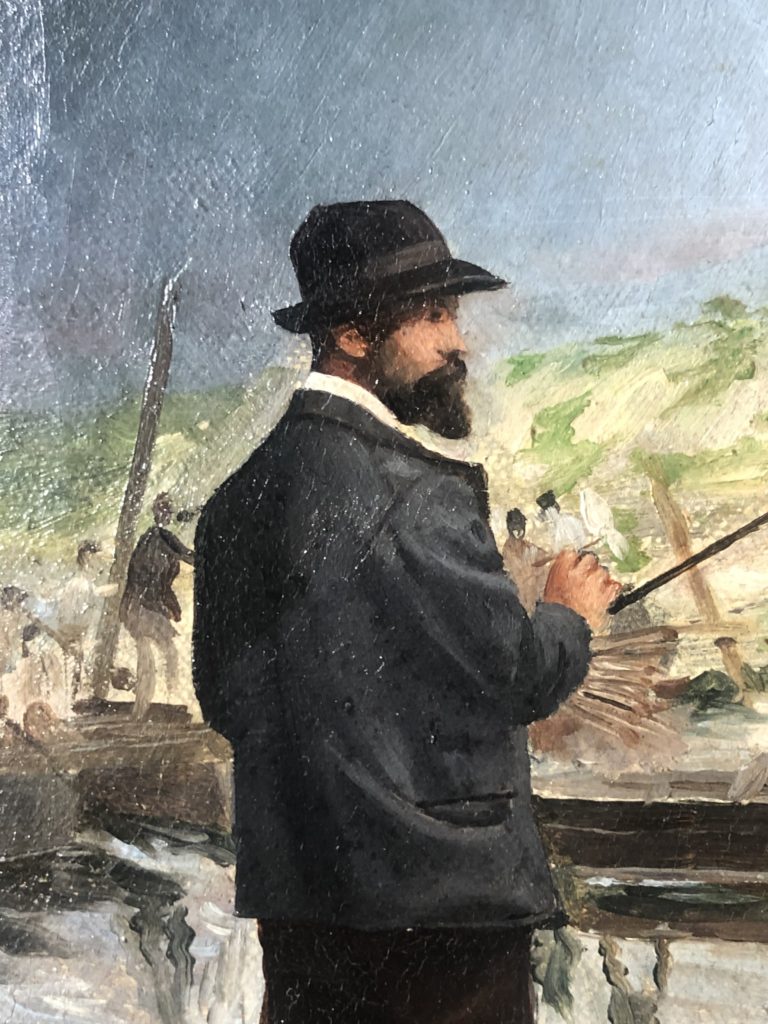
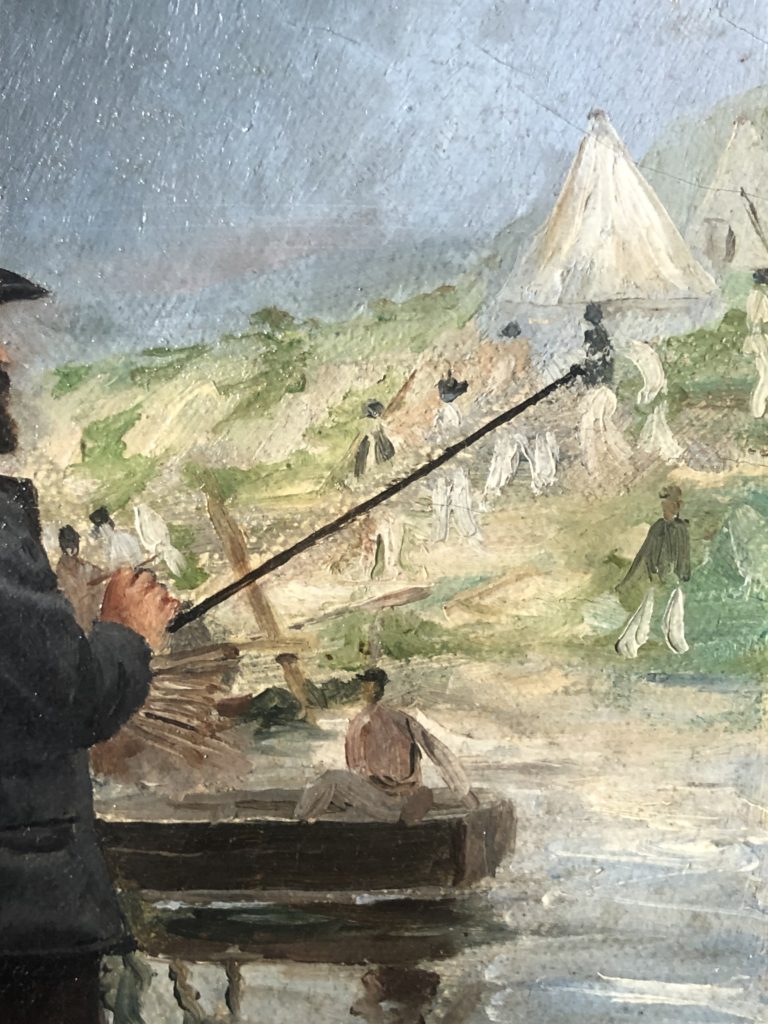
We want to know what you think! Share your response in the comments section below to help us solve this mystery!
Update (September 9, 2021):
Fine Art Connoisseur magazine Editor-in-Chief Peter Trippi has this to share:
“Damien Forest’s (wonderful) painting almost certainly depicts Edouard Detaille (1848-1912), the prominent French military artist. The tents in the background are of a design inspired by Plains Indian tipis, adopted by the U.S. army in 1856. That design was then used by European armies. (At that time, French and American uniforms, weapons, and equipment were quite similar.)”

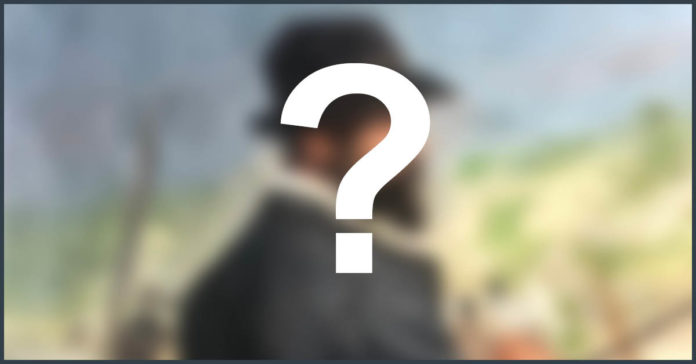
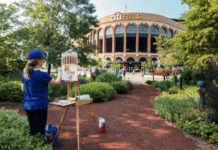


A reverse image search on Tineye reveals the following information:
F. BARLLIERE. School of traveling painters of Indochina. Probably a pupil of R. Bassouls.
Hanoi Street.
Oil on canvas signed, located Hanoi, after BASSOULS and dated 1911 lower right.
Dimensions: 38×45,5 cm. (Small old restoration).
Hi Denis
Thanks for your comment
I found the same information but obviously it does not match neither with the painting (dimensions 63 x 74 cm) nor with with subject painted
The painting isn’t signed nor dated
Best
The artist may be Joaquín Sorolla y Bastida. He was known to paint outdoors at a frantic pace… also he is usually shown with a similar beard to the artist shown here.
Have you considered this may be a plein air study for the later studio work by F. Barlliere? Just because it is larger does not mean the artist might not have decided to size it down in the studio. Another possibility is that it is a copy of the smaller work done by another artist in training. It appears to me to be a study.
Very long brushes like Sorolla used. …Possibly his portrait…
No, it is a maul stick.🙃
The artist in the painting looks a lot like Paul Cezanne. The author may be one of his students.
The more I look at it the more I am convinced that it is a poorly contrived gag. Inconsistencies
allover. This looks like a modern day construction site with the shed designed for storing building materials and equipment. Plein air artists would build umbrella-like structures with even lighting around and not this elaborate. To the right are smoothly cut members and we see what looks like the ground floor of a proposed cottage. The “painter” is supposedly looking at his subject which does not fit with the surroundings. The “painting” is in a small settlement by the river devoid of tall trees while the painter is in the woods, between him and the river would have been trees to obstruct his view. For such a large painting he is using a very tiny brush, like a liner. He has no palette, no box of paint, no rags, no brushes, no mediums etc.
The question should be whose painting it is that the “composer” used as a prop.
Suggestions possibly worth investigating:
Lucy Angeline Bacon (July 30, 1857 – October 17, 1932) was a Californian artist known for her California Impressionist oil paintings of florals, landscapes and still life. She studied in Paris under the Impressionist Camille Pissarro. She is the only known Californian artist to have studied under any of the great French Impressionists. However, she appears to have gone by the name of Lucy Bacon, without using her middle name. Source: https://en.wikipedia.org/wiki/Lucy_Bacon
Anna Richards Brewster (1870 – August 13, 1952), Philadephia. “She studied at Cowles Art School in Boston, where she won a First Scholarship in Ladies Life Classes in 1888, as well as with William Merritt Chase and John LaFarge at the Art Students League of New York in 1890.[2] In 1890, she won the Dodge Prize awarded by the National Academy for the best picture painted by an American woman of any age. The winning painting, titled An Interlude to Chopin, has since been lost.[3] She traveled to Europe periodically between 1890 and 1895, painting alongside her father in England, Ireland and Scotland, and studying at Académie Julian in Paris.[4] In 1896, she relocated to London where she lived for nine years, keeping a public studio in Chelsea and exhibiting four times at the Royal Academy of Arts.[5]” Source: https://en.wikipedia.org/wiki/Anna_Richards_Brewster
I should think it would be difficult to identify an artist of that era by the beard alone, as beards were fashionable at the time. It could be Cezanne, although in photographs his beard often looked more ‘bushy’. Renoir also wore a beard, wasn’t very tall, and had a relatively short nose.
It is indeed possible that the artist who painted this unusual work was not American, because Impressionist painters from across Europe, North America, and from the southern hemisphere, gravitated to France during the late 1800s until about the mid 1900s (and after 1900 or so could follow the art trend through photographs). Many went home to paint similar scenes, albeit realistically natural scenes from their own countries as per the fundamentals of plein air painting.
Other non-USA possibilities:
A British impressionist artist who had the initials “AB” was Amy Katherine Browning; [also known as Amy Dugdale; Amy Katherine Dugdale (31 March 1881 – 27 January 1978)] .
A.M.E Bale (Alice Marian Ellen Bale) was a member of the Australian Tonalists (a group founded by Max Meldrum) and the founder of the the “Twenty Melbourne Painters Society” which is ongoing. She exhibited in Britain as well as in Australia. I doubt the work is hers, however, I could not help but note that similarities with some scenes painted by the Australian Tonalists school. For example, Percy Leason’s “Caravan Eltham Park”, ~1930 and “Campsite study San Remo” ~1934.
Cheers and good luck
Janette (Australia)
Earl Scheib
American painting definitely, but not 19th century. This is a tongue in cheek painting within a painting of a Cezanne-like figure, but look at his shoes! They are 20th century. And this playful work of art could have appeared after the 1915 modern painting exhibit in Paris, perhaps as late as 1920s or 1930s. Brush strokes are loose, and playful.
Albert Bierstadt was a famous painter of the American West and of Indians. This painting is an enigma, because the surroundings- trees, tent, etc. are very well-rendered. But the figure is quite crudely done, as are the figures in the painting. Perhaps the painting is simply incomplete, since the shoes of the painter look quite well finished, yet the clothing is flat. The artist appears to be painting pictures of teepees, which puts him somewhere in the US Also. the artist in the picture is a spitting image of Bierstadt. Bierstadt frequently painted large canvases, so the canvas size is not unusual for him.
My guess is that Bierstadt (or a student) did this to demonstrate the method he used to do large plein air works. He is very specific and detailed. The canvas can be rolled in and out of the tent, where it could remain protected until finished. The wicker sticks provide a wind break. The floor boards are raised up off the soil, to prevent water damage from heavy rain.
To me, this piece is an instruction manual on how to build a portable structure for a plein air painter of large works. Because of this purpose, there was no need to present a finished work
My buddy Terry, a Western Painter himself, agrees with you:
Albert Bierstadt painted out West and was noted for his large landscape paintings. He was German-American and part of the Hudson River School. This looks to possibly be a self portrait of him doing a painting on location. The figure resembles Bierstadt.
I agree. The spitting image of Albert Bierstadt painting by a river with what looks to be teepees in the background and villagers either coming or going from the site by fishing boat. Bierstadt did numerous paintings of Indian encampments, fishing, canoes, Columbus landing, etc. In some of these you can see storage structures that look similar to this painting tent. My guess is that whoever set up the painting maybe learned something from the natives and/or Bierstadt. Also because he was born in Germany he returned to Europe several times to paint. So not unlikely to have been purchased there. Bierstadt taught at the National Academy of Design where he had a student named William Bliss Baker. Maybe this was done by Baker of his teacher who painted in large scale as this illustrates.
The artist that instantly came to my mind was Frederic Bazille. He hung out with the early impressionists and was known for figurative and landscape art, especially including other artists works, or other artists in the process of creating art themselves. He definitely could have left a trail of paintings in France, as it was where he lived and worked.
It sure what all the fuss is about. It appears to be painting done from a photograph of a staged scene.
Could it be a Renoir? He painted large canvases outdoors and was associated with some of the artists mentioned above.
I guess Antoine-Louis Barye. School of Barbizon.
Fascinating read .
I love a good mystery
Hope you post a final deduction
The head looks like Courbet….also the stance. May have been taken from “Bonjour Monsieur Courbet” and put in a suit.
The brushwork looks more like Berthe Morisot’s, with the long slashes….
Maybe it is a student work….
It looks more like Sorolla, than Cezanne. Or a young Monet. Sorolla, however, did a lot of figurative painting in historical/social realist subjects. One of his protoge’s was Alberto Rubio… Not really an “AB”, but maybe, if the B is a sloppy ‘R’. Sorolla died in 1923 (I looked it up).
Immediately my mind went to Manet (not Monet but E. Manet). What fun. Can’t wait to see if the puzzle is put together. More of these stories will generate a lot more art study for us. ;o)
Its definitively a « construction » of a painting! First a setting, in the woods, crudely done, no details; then a shed, with more details and a few pointers to construction activities. Let’s add a painter to this, with his painting. They do look completely artificial in this setting.
Quite an elaborate hoax, of at least an elaborate play with Plein Air painting!
Could the painting be by Amédée Joullin (1862-1917) of his teacher Jules Tavernier (1844-1889)? Tavernier painted scenes of American Native tribes for Harper’s Weekly in the 1870s. This painting in question appears to have Indian teepees. Tavernier wrote a letter from Cheyenne, Wyoming to his mother in France on May 7, 1874, expressing, “I am about to cross one of the wildest regions [of the West], where no artist has gone yet.” Period-wise and stylistically, I would venture to guess that the painting was created circa 1880.
It’s certainly an intriguing work of art! Good luck with solving the mystery!
I agree with those who are guessing Albert Bierstadt. It looks like Bierstadt, he was famous for very large works, he did many scenes like this one…along a river or lake with an encampment, those look like teepees in the background and he did Indian motifs. He traveled to Europe which could easily explain finding the painting in Europe.
There are lots of questions..The “AB” initials suggest the painting was done by Bierstadt, but it could easily be a painting “of” him…perhaps by a student?
Food for thought. The figure appears to be standing on a sheet of plywood, not common production until around 1920. The shoes appear to be slip on loafer types. These were not common in production until around the 1930’s. Bierstadt died in 1902.
There seems to be some artistic fantasy here.
It looks like the work of James Carroll Beckwith (1852-1917) . He was a successful portrait and landscape painter in the late 19th century. He has other paintings/pastels of artists working.
He trained at the National Academy of Design and later joined the Parisian atelier of portraitist Emile Auguste Carolus-Duran. This was where he developed his impressionist style.
His paintings are within the holdings of Metropolitan Museum of Art, NY Historical Society, Smithsonian American Art Museum and Wadsworth Atheneum of Art.
I can’t contribute much to this, but what I noticed right away was the subject matter being painted. The figures on the bank look to be wearing uniforms and the figure down by the bank seems to be wearing what was known as a kepi. Also the figure manning the boat with the red shirt seems to also be wearing a hat consistent with the mid 1800’s with what looks to be a canteen on his hip. But the most interesting thing I see are the tent like structures up the hill. There was a tent called the Sibley and in Europe it was called a Bell Tent, all in use just prior and during the Civil War. A rather intriguing painting.
Looking at the background those may be teepees (note the flap like structures possibly covering an entrance on both) and the figures may be
soldiers–could this be a depiction of an army raid on a native american village? That would also partially explain the tenting and flooring under the larger figure.
Actually the shoes could be 1840’s or 1850’s fashion– see this image https://collections.mfa.org/objects/73883. I agree that the background images may be Sibley Bell tents. On further reflection, I would image that this may simply be an artist’s rendition of an US army camp. I think it is a study and that the artist is most likely a student not a master.